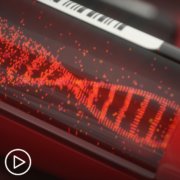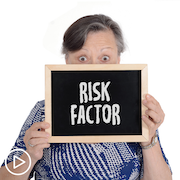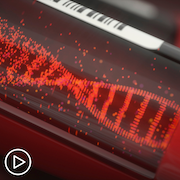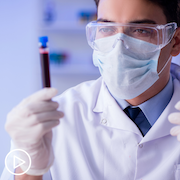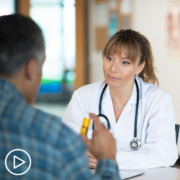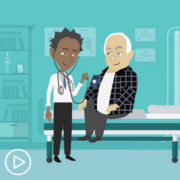CLL Treatment: Finding the Best Option for YOU from Patient Empowerment Network on Vimeo.
How could genetic testing results impact your chronic lymphocytic leukemia (CLL) treatment options and overall care? Dr. Jennifer Woyach discusses essential molecular testing and provides tools for self-advocacy and decision making.
Dr. Jennifer Woyach is a hematologist-oncologist specializing in chronic lymphocytic leukemia (CLL) at Ohio State’s Comprehensive Cancer Center – James Cancer Hospital & Solove Research Institute. Find out more about this expert here.
Download Program Resource Guide
See More From INSIST! CLL
Related Resources
Transcript:
Katherine:
Welcome to Insist CLL, a program focused on empowering chronic lymphocytic leukemia patients to take an active role and insist on better care. Today, we’ll discuss the latest advances in CLL, including the role of genetic testing and how this may affect treatment options. I’m Katherine Banwell, your host for today’s program. Joining me is Dr. Jennifer Woyach. Welcome. Would you please introduce yourself?
Dr. Woyach:
Sure. My name is Jennifer Woyach. I’m a CLL specialist from the Ohio State University.
Katherine:
Thank you. A reminder, this program is not a substitute for seeking medical advice. Please refer to your own healthcare team. Well, Dr. Woyach, let’s start by understanding CLL. Would you briefly walk us through what CLL actually is?
Dr. Woyach:
Sure. CLL is a cancer of the blood, the lymph nodes, and the bone marrow.
And it happens when a particular type of white blood cell called a B lymphocyte acquires genetic mutations and transforms into a cancer cell. And then, over time, those cancer cells continue to grow and divide. And they can cause symptoms such as enlarged lymph nodes if the cells get stuck in the lymph nodes and continue to grow there. It can cause a high white blood cell count, which usually doesn’t cause any symptoms but is one of the things that we see often in CLL. And then, it can also cause the bone marrow to not be able to produce normal cells because it can get so infiltrated or so full of CLL cells.
And this can cause things like anemia, which is lowering of the red blood cell count and thrombocytopenia, which is lowering of your platelet count.
Katherine:
What are the steps involved in reaching a diagnosis?
Dr. Woyach:
CLL is an interesting disease because it’s one of the only cancers that does not require a biopsy of something for a diagnosis.
So, we can, actually, make the diagnosis of CLL based on the peripheral blood. So, just a blood draw in somebody’s doctor’s office. Usually, CLL is diagnosed in the asymptomatic stage. So, somebody goes to their primary care doctor, has blood drawn usually for another reason, and is found to have a high white blood cell count or sometimes even a fairly normal white blood cell count but a high percentage of lymphocytes. That certain type of cancerous white blood cell. So, the next step in the diagnosis then is something called peripheral blood flow cytometry, which is a specialized test where we look at the markers or antigens on the surface of white blood cells.
So, there is kind of a code of these markers on the surface of all of your blood cells that can tell what type of cells they are. So, for CLL in particular, we’ll see that the cells express some of the normal markers we would see on a normal B lymphocyte.
Things like CD19, CD20, CD23. But they also express a marker called CD5, which is found on normal T lymphocytes but shouldn’t be found on B lymphocytes. And so, this collection of surface markers can make the diagnosis of CLL. Sometimes, we do need to do extra studies like a bone marrow biopsy or a lymph node biopsy. But often times, those are not necessary at the time of diagnosis.
Katherine:
When you meet with patients, Dr. Woyach, what are some common misconceptions that you hear about?
Dr. Woyach:
I think the biggest thing that I hear, and grant it I see a lot of patients after they’ve been diagnosed by someone, gone to see an oncologist and then, come to me after, but one of the common things that I hear is that somebody has told them along the way that they have the good type of cancer, which I think is not a very helpful thing to hear as a patient because, of course, no cancer is a good type of cancer.
I think it’s important to note that CLL is one that has a lot of treatment options and usually extended survival. But I think that’s one of the most common misconceptions that I hear.
Katherine:
Before we get deeper into our conversation about genetics, there are a few terms that patients are often confused by. As a primer, I thought we could start by defining some of these terms. First, what is genetic or molecular testing?
Dr. Woyach:
So, all cancer cells will have a collection of mutations or abnormalities in the DNA that either make the cell a cancer cell or make it behave in a certain way. And so, these mutations are referred to as the genetic abnormalities of the CLL cells. So, when we talk about genetic testing in CLL, we use it to mean a number of things. We can use it to look specifically for types of mutations so types of genetic abnormalities.
We also sometimes use that as a kind of catch all term like genetic or molecular testing also to refer to looking at changes in the chromosomes inside of a CLL cell. That’s also called cytogenetic testing. And then, we also use a number of tests in CLL where we look at specific, not necessarily abnormalities, but just changes in the cell that can indicate a certain type of behavior.
Katherine:
How is this different from genomic testing?
Dr. Woyach:
So, genetic and genomic testing, I think, are usually used interchangeably. But sometimes, we use them in different contexts but they really mean the same thing in this case.
Katherine:
Okay. And what is a chromosome change?
Dr. Woyach:
So, as you might remember from biology class maybe a long time ago, as it was for me, inside a cell, so a normal cell or a cancer cell, you have the nucleus, which holds the DNA.
And the DNA is organized into chromosomes. And so, when a cell goes through division, it takes those chromosomes, copies them and then, breaks them apart into two different cells. So, changes can happen in the level of the DNA itself. So, a mutation where one base is changed to something different. So, that would be just like a single nucleotide change. And that’s something you’re not going to see as a change to a chromosome. Another thing that can happen in CLL and in other cancers, too, is that during that process of cell division, an entire chromosome could be duplicated. It could be absent.
More commonly, parts of chromosomes can change. This is all because cancer cells just do a very poor job of editing their division.
An in normal cells, there are multiple steps along the way from the process of copying the genes to copying the chromosomes to doing the division. And every step along the way, if something happens incorrectly, which happens a lot, the cell usually just dies. But a cancer cell is not going to do that because it has so many signals that keep telling it to stay alive that it can tolerate a lot of different abnormalities. And so, you end up with cells that are just very different from what you would see normally.
Katherine:
All right. Well, that’s a great way for us to start. Let’s go into the discussion of the relationship between testing and CLL. How is testing administered?
Dr. Woyach:
So, almost all testing, in terms of molecular genomic testing in CLL, can be done on a blood sample. So, that’s one important thing.
The CLL guidelines recommend that testing for certain prognostic factors be done before the administration of therapy. So, at the very least, before somebody starts treatment, they should have these tests performed. In my practice and I think most CLL specialists find it really helpful to do these tests, not necessarily just at the time of treatment but really at the time of diagnosis or the time we first see the patient because CLL is a very heterogenous disease, which means that it behaves very differently in different people. So, there are some people that are diagnosed and will go 10 or 20 years before they need any treatment.
And many don’t need treatment at all. Whereas other people are very likely to need treatment within the first few years after diagnosis. Some of the genetic tests that we do can help counsel patients on where they’re likely to fall in that spectrum.
And so, I think that’s helpful for people to know early on in the disease course. But really, the tests can be performed at any time before treatment
Katherine:
Have there been advances in testing?
Dr. Woyach:
Absolutely. I think in every cancer, we’ve learned so much more about the biology of the disease, specific mutations that cause specific behaviors of cells, and really much more in CLL about the common genetic changes and what those means to response to therapy.
Katherine:
The goal of this program, Dr. Woyach, is to provide the confidence and tools for patients to advocate for the essential tests to get the best care personalized to them. Are there specific tests that patients should make sure they have?
Dr. Woyach:
Yeah. In CLL, I would say there are three that are very, very important before starting treatment. The first is something called the IGHV mutational status.
What that is defined as is the changes in the variable region of the immunoglobulin heavy chain. That’s a big mouthful that doesn’t mean a lot to most people. So, I’ll give you just a little background on what that really means biologically and then, what that means clinically. So, every B lymphocyte, so a normal B lymphocyte and a CLL cell, has receptors on the surface of the cell that allow it to interact with the environment. And in a normal B lymphocyte, this is really important for the immune system. So, bacteria, virus, something is in the body and the B cell surface receptor is going to be able to recognize that that’s not supposed to be there and then, do something about it.
In CLL, the surface receptors don’t do a lot of interacting with the outside environment but they’re still present there. And in a normal B cell development, the B cells are initially formed in the bone marrow.
And at the time that they’re formed, every one of those receptors is exactly the same. So, we can do DNA sequencing on those receptors and you’ll see that every one is identical. So, during a normal development of a B cell, it undergoes this process that’s called somatic hypermutation, which is where those receptors mutate or change. And that’s important because then, they can recognize different things. And so, you end up with this whole repertoire of thousands or millions of B cells that all are a little bit different and can recognize something different.
So, CLL cells, they’re all clonally related to each other. They’re all going to have the same receptor on their surface. And about 60% of the time that receptor is different than the newly born B cells. And so, this is probably a little bit more simplistic than it actually is. But the way we think about that is that those B cells or those CLL cells, which we call mutated because they underwent that mutational process, we think that that means that they come from a more mature initiating cell.
And they tend to be less aggressive, more slow growing. The other 40% of patients, if you look at the receptor on their surface, it’s exactly the same as the new B cells in the bone marrow. And we call those IGHV unmutated because they haven’t done that mutational process. And they behave very differently. So, in mutated CLL, only about half of people will ever need therapy in their lives. An average time from diagnosis to first treatment is about 10 years. In contrast to those patients who have unmutated IGHV, basically, all of those people will need therapy at some point in their lives. And average time from diagnosis to first treatment is about three years.
So, you can see how it really breaks people up into two very different categories of disease.
So, that’s the first test and one that’s really important. That’s also one that doesn’t change during the course of the disease. So, if somebody is diagnosed with mutated CLL, it’s always mutated. So, the next marker that’s important is, actually, chromosome changes. So, we know that there are a few different recurrent chromosome abnormalities in CLL that are common and important prognostically. So, one of these is a deletion of part of chromosome 13. It’s called a 13q deletion. It indicates, again, very slow growing CLL. Patients how have normal chromosomes also are very good disease biology.
Some people have an extra copy of chromosome 12. That’s called trisomy 12 and that’s an intermediate marker. And then, there are two markers that are associated with a little bit more aggressive CLL. One is a deletion of proto chromosome 11. That’s called an 11q deletion.
And the other one is a deletion of proto chromosome 17 called a 17p deletion. These are all abnormalities that are important to test for. And the way that we test for these is something called FISH testing. And FISH stands for fluorescence in situ hybridization. And it’s a way to use an antibody to look for specific abnormalities in the CLL cells. So, that’s important. And another thing that can be done at specialized centers is something called stimulated cytogenetics. So, I mentioned to you with FISH testing, we’re looking for specific abnormalities with antibodies. But the things that we don’t test for we’re not going to see.
So, if they have a chromosome change that we don’t have an antibody looking at, we’ll never detect it. And we know that patients with CLL who have what’s called a complex karyotype, which is three or more chromosome abnormalities, they also have more aggressive disease.
So, like I said, at specialized centers, we can do what’s called a stimulated karyotype, which is where we look at all of the chromosomes. So, that’s FISH testing and karyotype. And then, the last thing is, actually, doing DNA sequencing for a specific mutation called a TP53 mutation. And TP53 is an important tumor suppressor protein. And it is mutated quite commonly in CLL. About eight to ten percent of patients at the time of first treatment and, actually, up to about forty percent of people later on in the course of the disease. Most of the time, we see TP53 mutations occur at the same time as 17p deletions. About 80% of the time, those occur together but they can occur on their own.
So, that’s the third test that’s often helpful, especially prior to starting treatment.
Katherine:
Do patients need to be retested over time?
Dr. Woyach:
Yeah. So, for the TP53 mutation and for FISH, it’s important to test for those before each line of therapy. Because those are so important in indicating disease biology and, specifically, with the 17p deletion and TP53 mutation, those indicate patients that are likely to not have as good of a response to treatment. It’s always important to check for those prior to therapy.
Katherine:
We have a patient question. I have 17p deletion. Should I be worried?
Dr. Woyach:
So, 17p deletion is usually associated with more aggressive disease biology almost always associated with that unmutated IGHV. The reason I bring that up is there are a very small subset of patients who have 17p deletion and mutated IGHV who, actually, have pretty indolent or slow growing disease.
People who don’t, which is the majority of them with 17p deletion, do have a shortened time to treatment and shortened survival with most of our current therapies. There have been a lot of advances though in the treatment of 17p deleted CLL. And may of our newer therapies can very much prolong the remission time in the lives of patients with 17p deletion.
Katherine:
Dr. Woyach, how do these chromosomal changes affect disease progression and prognosis?
Dr. Woyach:
So, the markers that are associated with more aggressive disease biology usually are going to be associated with people that need treatment within the first few years after diagnosis, especially those people who have 17p deletion, 11q deletion, unmutated IGHV.
Katherine:
What exactly are prognostic factors? Would you define that?
Dr. Woyach:
Sure. Prognostic factors, and I mentioned three of them, the IGHV, FISH, and the TP53 mutation, are ones that have been studied extensively and shown that the presence of this marker or some change in this marker is associated with a change in the biology of the disease or in the response to therapy.
Katherine:
How does the identification of these changes or mutations affect treatment options?
Dr. Woyach:
Well, right now, we’re lucky in CLL because we have a lot of treatment options. I would say the most important changes when we’re talking about somebody with CLL that is about to start their first treatment is the decision of whether chemotherapy is ever appropriate. So, almost everybody with CLL now is treated exclusively with targeted therapies.
So, nonchemotherapeutic options. There are some people who are young, and in CLL terms that means under the age of 65, who have mutated IGHV and who otherwise have good genetic list disease. So, normal chromosomes of the 13q deletion, no TP53 mutation. That small subset of patients, actually, has the potential to be cured with a specific type of chemotherapy. It’s called FCR or fludarabine, cyclophosphamide, rituximab. So, for those young, healthy patients, it’s really important to know those risk factors to know if they are in that group that has that potential for cure.
The converse to that is if patients don’t fall in that group, they probably shouldn’t receive chemotherapy as their first treatment because it’s not as effective as our other therapies.
Katherine:
Yeah. It makes sense.
Dr. Woyach:
And then, even in the future with first and other treatments with novel therapies, we know that patients with 17p deletion and TP53 mutation tend to have a shorter response time. And so, what I use that for in my practice is I know that those are people that I really have to be sure that we’re following them closely, taking any signs of progression seriously, and always have a back up plan for what we’re going to do if this treatment doesn’t work.
Katherine:
We have another question from a patient who wants to know if their children will inherit CLL. Is there any link between inherited mutations and CLL?
Dr. Woyach:
That’s a very, very common and really important question. I would say of the hematologic cancers, CLL is one with higher linkage in families, which means that people with CLL are more likely to have another family member with CLL though it’s still not very common.
And it’s very different from breast cancer or the solid tumors where we know that these specific mutations indicate families that are going to have risk of disease. There has actually been a lot of study over the years of families that tend to have multiple people with CLL. Unfortunately, there really have not been genes identified that are the reason for those family linkages. I think there has been only one family that I know of where they’ve actually found a gene that was likely the cause of multiple family members’ illnesses. So, yeah, there is no indication to test family members.
I tell people do not worry that you’re going to pass this to your children or your grandchildren. CLL is not something that we should be using as like a marker of whether you should have kids or should have anything like that.
So, maybe a little more likely in family members but not enough to really be worried about that.
Katherine:
What are the differences or difference between inherited and acquired genetic mutations?
Dr. Woyach:
So, inherited mutations are those that you get from your parents. And there are lots of inherited mutations that, actually, can predispose to cancer. Specifically, I mentioned the TP53 mutation and CLL cells. Well, there are also people who inherit a TP53 mutation have risk factors for multiple cancers. And CLL, specifically, every mutation that we talk about is an acquired mutation. So, that’s also known as a somatic mutation. So, they’re mutations in the cancer cells. But if you did DNA sequencing of the normal cells, they would not be there.
Katherine:
We have a question from a patient. If I have FCR, does that rule out me using a targeted therapy later on?
Dr. Woyach:
Absolutely not. And, actually, all of the studies of the targeted therapies, all of the early studies were done in people who previously had had chemotherapy. Most of them had received FCR. So, certainly, receiving chemotherapy doesn’t mean that you can’t get a targeted therapy later on.
Katherine:
What are other factors that are important to consider when deciding on a treatment route?
Dr. Woyach:
So, besides the genetic factors we talked about, other things are age and very closely related to age is fitness status. So, how active is somebody? How able are they to do all of their normal activities? Are there other health problems that we need to be concerned about when thinking of treatment?
As well, certain medications can influence treatment choices, specifically, with oral therapies where there might be drug interactions. And then, also a lot of the decision of frontline therapy is patient preference right now. So, do people prefer to have a time limited therapy? Do they prefer to have an indefinite therapy? Do they prefer an all p.o. regimen or a mix of p.o. and IV? So, there are definitely a lot of considerations when thinking about frontline treatment.
Katherine:
Dr. Woyach, what do you feel is the patient’s role in this conversation about treatment approaches?
Dr. Woyach:
I think that, obviously, the patient is the most important part of the talk of treatment indications. Like I mentioned, sometimes we have the discussion of chemotherapy versus a targeted therapy. More often, the discussion is we have three approved frontline CLL therapies right now. We have two BTK inhibitors or Bruton’s tyrosine kinase inhibitors, ibrutinib, acalabrutinib.
And then, we have a BCL-2, venetoclax, that’s given in combination with an antibody called obinutuzumab. These are very different treatments in terms of side effects, [inaudible] [00:28:13] how they’re administered, how often they’re administered, just as an example. The BTK inhibitors are pills. And they’re meant to be given indefinitely. So, you start them with plans that you’re not going to stop them, unless the patient doesn’t tolerate them or they stop working. And so, with that type of regimen, you have the kind of burden of being on treatment for a long period of time.
But on the flipside, it’s very easy to start treatment. So, if you decide you want a BTK inhibitor, I write a prescription for it, it comes to your house, you start it. I usually see patients monthly for the first six months and then, we go to every three months. It’s very easy to start treatment.
The other type of treatment, the Venetoclax plus with the obinutuzumab regimen, that’s the BCL-2 inhibitor with an antibody, it’s a finite therapy. So, people are treated for a year and then, they go off treatment. The flipside of that is they’re a lot more time intensive in the beginning. So, you have the IV therapy with the obinutuzumab. Venetoclax you, actually, have to ramp up the dose so patients have to come in weekly for the first five weeks and they have to come in monthly for their infusions. So, it’s much more time intensive upfront but then, you get to stop treatment. And so, those are considerations that I can’t answer for somebody.
I don’t know which one people would prefer and people prefer different things. So, we spend a lot of time talking about all of the different scenarios and what’s going to make the therapy work best for the patient.
Katherine:
How can patients stay informed about CLL?
Dr. Woyach:
There is a lot of good information about CLL that’s available online through The Leukemia & Lymphoma Society.
They have a number of resources for lots of different cancers, including CLL. There are a number of different patient centered websites. One is called the CLL Society. There are others that are heavily moderated, provide a lot of good information, and tend to stay on topic with CLL current developments and don’t get into the weeds too much I would say.
Katherine:
If there are side effects, what would some of the side effects be for these targeted therapies?
Dr. Woyach:
So, it depends on the drug. So, BTK inhibitors, specifically, ibrutinib can cause some joint and muscle pain, some rashes, diarrhea, heart burn. Those are things that tend to, if they’re going to happen, usually happen earlier on in treatment and tend to get better over time. It can also cause high blood pressure. It can cause an abnormal heart rhythm called atrial fibrillation.
So, those are things we watch out for with ibrutinib. Acalabrutinib really has all of the same side effects but for many of them, they don’t occur as often. And then, the tradeoff there is ibrutinib is given once a day and acalabrutinib is given twice a day. With venetoclax plus obinutuzumab with that regimen, you get a lot more hematologic toxicity. So, you see more lowering of the good white blood cell count, which is, obviously, a risk for infections. That regimen comes with a risk of something called tumor lysis syndrome, which is where the cells can break down too quickly and cause damage to the kidneys, damage to the heart.
It can also cause some GI disturbance like some diarrhea, nausea, abdominal pain, things like that. I see there are a lot of side effects. And, of course, when I’m talking to a patient about treatment, we go over them in more detail than that. But I think the important thing is with all of these therapies, we do have ways to manage these side effects.
One thing I think is important for patients to remember is your doctor doesn’t know you’re having side effects unless you tell them. So, we know that people have these side effects. But if you don’t tell us that you’re having diarrhea or heart burn or things like that, we can’t help with it. And we have a lot of medicines that can help these things.
Katherine:
That’s a good point. Are there emerging treatments patients should know about?
Dr. Woyach:
Yeah. There are a lot of really exciting things going on in CLL right now. And CLL is a disease that has been completely transformed in the last five to ten years and is poised to do so again. So, I mentioned these therapies that we use for frontline treatment and there are clinical trials now combining them together. So, these agents work so well on their own. Are they going to be even better if we add them together?
There are also newer target therapies, different targets that we are finding increasingly important in CLL, as well as a modality called CAR-T cells, which most people have heard of where we take patients’ own T cells, modify them in the lab and then, give them back with a goal of getting those cells engineered to kill CLL cells.
These are all things that are not ready for prime time in CLL yet but are available in clinical trials. And I think one other thing I’d really like to put a plug in for is clinical trials in CLL because right now, we’re at a point where our therapies are really very good. But if people just do those treatments, we are never going to figure out which one is the best or figure out, for specific types of patients, which treatment is the best. And so, I advocate that any of my patients that are eligible for clinical trials should consider them because that’s how we make progress in the disease from an altruistic sense.
That’s how we make things better for everybody. That’s one way a patient can think about it. But more personally than that, being in a clinical trial gives somebody the opportunity to get a treatment that they otherwise wouldn’t get that might be better than our standard of care therapies.
Katherine:
Dr. Woyach, as a researcher in the field, why are you hopeful?
Dr. Woyach:
I am so hopeful in CLL because there is so much that we’re learning every day about the biology of the disease, about specific mutations and other genetic factors that are important and really can be targeted by new drugs. Paralleling our understanding of the disease, there also are many more techniques to make these targeted therapies that kill cancer cells selectively while sparing normal cells and making our drugs even more tolerable.
And I think both the targeted therapies like this and the potential of combining them, figuring out sequences that are best but then, also these newer modalities where we, actually, get the immune system involved like the CAR-T cells. They’re making CAR NK cells now. And just lots of other strategies that could be used together with targeted therapies to, hopefully, cure the disease.
Katherine:
Thank you for taking the time to join us today and sharing all of this information with the patients. We appreciate it.
Dr. Woyach:
Of course. It’s my pleasure.
Katherine:
Please take a moment to fill out our survey. It helps us as we plan upcoming programs. And thank you to all of our partners. To learn more about CLL and to access tools to help you become a proactive patient, visit Powerfulpatients.org. I’m Katherine Banwell.


